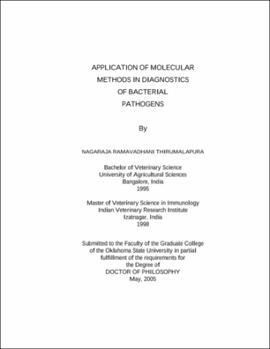| dc.contributor.advisor | Malayer, Jerry | |
| dc.contributor.author | Thirumalapura, Nagaraja Ramavadhani | |
| dc.date.accessioned | 2013-11-26T08:35:18Z | |
| dc.date.available | 2013-11-26T08:35:18Z | |
| dc.date.issued | 2005-05 | |
| dc.identifier.uri | https://hdl.handle.net/11244/7676 | |
| dc.description.abstract | Scope and Method of study: The present study investigated the applications of recent advances in molecular techniques for developing novel diagnostics of bacterial pathogens. The study adapted an in vitro selection method known as systematic evolution of ligands by exponential enrichment (SELEX) for generation of ssDNA aptamers against Francisella tularensis subspecies tularensis (Strain OSU 10) lipopolysaccharide (LPS). The study also reports the 1 H- and 13C-NMR spectroscopy structural analysis of O-antigen of F. tularensis subspecies tularensis (strain OSU 10). Further, microarray based immunoassays were developed for the detection of antibodies to bacterial antigens. Findings and Conclusions: Single stranded DNA aptamers were selected against the purified carbohydrate part of LPS (containing core oligosaccharide and O-polysaccharide) from F. tularensis subspecies tularensis (Strain OSU 10). A selected aptamer Ft1 showed specific binding to LPS from F. tularensis subspecies tularensis and subspecies holartica. However, the aptamer did not show significant binding to whole cells of F. tularensis. This could be due to recognition of the core oligosaccharide part of the LPS by the aptamer and the core oligosaccharide may not be readily accessible on the surface of the bacterium. Alternatively, use of whole bacterial cells as target in the selection process could help in developing aptamers to surface targets of bacteria. Structural analysis suggested that the O-antigen of F. tularensis subspecies tularensis strain OSU 10 is identical to that of subspecies holarctica strain 15 and F. tularensis LVS and consists of repeating tetra-saccharide subunits: 4-(a-DGalpNAcAN-(1-4)- a-D-GalpNAcAN-(1-3)- B-D-QuipNAc-(1-2)-B -D-Quip4NFo-1). A microarray based immunoassay was developed for the detection of antibodies to lipopolysaccharides. The assay showed a hundred-fold greater sensitivity compared to conventional immunoassays. Further, bacterial cell arrays were developed for the detection and characterization of antibodies to cell surface antigens. These microarray-based immunoassays are multiplex in nature and have many potential applications including disease diagnosis and seroepidemiology. | |
| dc.format | application/pdf | |
| dc.language | en_US | |
| dc.rights | Copyright is held by the author who has granted the Oklahoma State University Library the non-exclusive right to share this material in its institutional repository. Contact Digital Library Services at lib-dls@okstate.edu or 405-744-9161 for the permission policy on the use, reproduction or distribution of this material. | |
| dc.title | Application of molecular methods in diagnostics of bacterial pathogens | |
| dc.contributor.committeeMember | Mort, Andrew | |
| dc.contributor.committeeMember | Morton, Rebecca | |
| dc.contributor.committeeMember | Clarke, Jean | |
| osu.filename | Thirumalapura_okstate_0664D_1081.pdf | |
| osu.accesstype | Open Access | |
| dc.type.genre | Dissertation | |
| dc.type.material | Text | |
| thesis.degree.discipline | Veterinary Biomedical Sciences | |
| thesis.degree.grantor | Oklahoma State University | |
